一、DWR简介
dwr是一个Ajax框架,官方网站:http://directwebremoting.org/dwr/,最新版本3.0.1,要求jdk1.6及以上。
如下图所示,可以通过DWR来调用Java方法,并通过DWR封装的工具类来对页面元素进行简单处理:
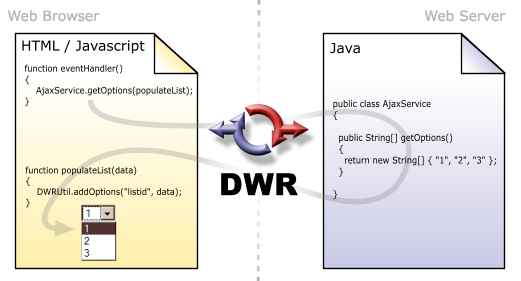
上面的展示是对Ajax的封装,简化了用户的操作,当然最常用的还是逆向Ajax(需要DWR2.0及以上版本),就是俗称的服务器端推送:
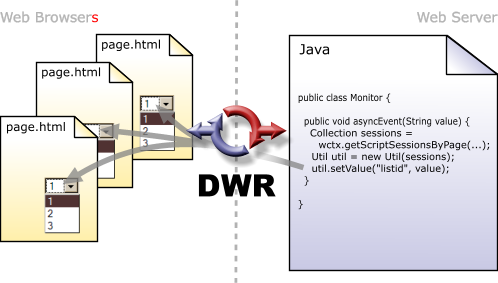
逆向Ajax相对比较难一点,下面先展示js调用Java方法的例子。
二、DWR示例-js调用Java方法
2.1 创建Web项目
创建Web项目,并将dwr-3.0.1-RELEASE.jar和commons-logging-1.2.jar放入WEB-INF/lib下,dwr-3.0.1-RELEASE.jar是DWR必须要的jar包,最新版本为3.0.1-RELEASE,它依赖commons-logging-1.2.jar日志包。最终项目结构如下:
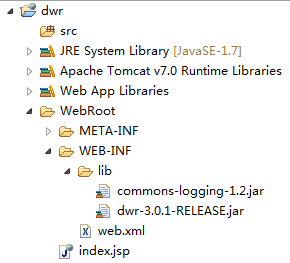
若使用Maven,则Maven坐标如下:
<dependency>
<groupId>org.directwebremoting</groupId>
<artifactId>dwr</artifactId>
<version>3.0.1-RELEASE</version>
</dependency>
<dependency>
<groupId>commons-logging</groupId>
<artifactId>commons-logging</artifactId>
<version>1.2</version>
</dependency>
Maven创建Web项目查看(待续)。本项目使用jdk1.7,tomcat7搭建。
2.2 修改web.xml
DWR的js调用Java代码,本质上还是通过Ajax来访问,因此需要在web.xml中配置DWR接收js请求的servlet,配置如下:
<?xml version="1.0" encoding="UTF-8"?>
<web-app xmlns:xsi="http://www.w3.org/2001/XMLSchema-instance" xmlns="http://xmlns.jcp.org/xml/ns/javaee" xsi:schemaLocation="http://xmlns.jcp.org/xml/ns/javaee http://xmlns.jcp.org/xml/ns/javaee/web-app_3_1.xsd"
id="WebApp_ID" version="3.1">
<display-name>testweb</display-name>
<servlet>
<servlet-name>dwr-invoker</servlet-name>
<!-- 接收js的Ajax请求的servlet -->
<servlet-class>org.directwebremoting.servlet.DwrServlet</servlet-class>
</servlet>
<servlet-mapping>
<servlet-name>dwr-invoker</servlet-name>
<!-- 拦截指定的URL -->
<url-pattern>/dwr/*</url-pattern>
</servlet-mapping>
<welcome-file-list>
<welcome-file>index.html</welcome-file>
<welcome-file>index.jsp</welcome-file>
</welcome-file-list>
</web-app>
若使用的不是jdk1.7及Tomcat7注意修改web.xml的头信息,为低版本。
2.3 创建被调用的Java类
创建一个普通的Java类即可,如下:
package yiwangzhibujian;
import java.util.Date;
/**
* @author yiwangzhibujian
*/
@SuppressWarnings("deprecation")
public class HelloWorld{
/**
* 无参无返回值
*/
public void helloNN(){
System.out.println(new Date().toLocaleString() + " js访问helloNN方法");
}
/**
* 有参无返回值
*/
public void helloYN(String name){
System.out.println(new Date().toLocaleString() + " js访问helloYN方法,name=" + name);
}
/**
* 无参有返回值
*/
public String helloNY(){
System.out.println(new Date().toLocaleString() + " js访问helloNY方法");
return "Hello World!";
}
/**
* 有参有返回值
*/
public String helloYY(String name){
System.out.println(new Date().toLocaleString() + " js访问helloYY方法,name=" + name);
return "Hello " + name;
}
}
通过DWR调用Java方法使用普通的Java类即可,不需要访问servlet。
2.4 创建DWR配置文件
在WEB-INF根路径下创建DWR的配置文件,dwr.xml
<!DOCTYPE dwr PUBLIC
"-//GetAhead Limited//DTD Direct Web Remoting 3.0//EN"
"http://getahead.org/dwr/dwr30.dtd">
<dwr>
<allow>
<create creator="new" javascript="HelloWorld">
<param name="class" value="yiwangzhibujian.HelloWorld" />
</create>
</allow>
</dwr>
create=“new”,即通过默认的构造方法使用new来创建对象,javascript="HelloWorld",HelloWorld表示调用类的名称,即在js中Java对象的名字,<param>即用来配置DWR访问的类。简单来说,value就是js要调用的类,javascript属性即是为这个类起一个简单的别名。
2.5 创建JSP页面
本示例简单的在index.jsp中编写:
<%@ page language="java" import="java.util.*" pageEncoding="UTF-8"%>
<%
String path=request.getContextPath();
String basePath=request.getScheme() + "://" + request.getServerName() + ":" + request.getServerPort() + path + "/";
%>
<!DOCTYPE HTML PUBLIC "-//W3C//DTD HTML 4.01 Transitional//EN">
<html>
<head>
<base href="<%=basePath%>">
<title>My JSP 'index.jsp' starting page</title>
<meta http-equiv="pragma" content="no-cache">
<meta http-equiv="cache-control" content="no-cache">
<meta http-equiv="expires" content="0">
<meta http-equiv="keywords" content="keyword1,keyword2,keyword3">
<meta http-equiv="description" content="This is my page">
<script type='text/javascript' src='dwr/engine.js'></script>
<script type='text/javascript' src='dwr/util.js'></script>
<script type='text/javascript' src='dwr/interface/HelloWorld.js'></script>
<style type="text/css">
td{
border: solid 1px;
}
</style>
</head>
<body>
<table>
<tr>
<td>无参无返回值</td>
<td colspan="3"><input type="button" value="helloNN" onclick="helloNN();"></td>
</tr>
<tr>
<td>有参无返回值</td>
<td colspan="2"><input type="text" id="helloYNName"></td>
<td><input type="button" value="helloYN" onclick="helloYN();"></td>
</tr>
<tr>
<td>无参有返回值</td>
<td><input type="button" value="helloNY" onclick="helloNY();"></td>
<td colspan="2"><input type="text" id="helloNYValue"></td>
</tr>
<tr>
<td>有参有返回值</td>
<td><input type="text" id="helloYYName"></td>
<td><input type="button" value="helloYY" onclick="helloYY();"></td>
<td><input type="text" id="helloYYValue"></td>
</tr>
</table>
</body>
<script type="text/javascript">
//无参无返回值
function helloNN(){
HelloWorld.helloNN();
}
//有参无返回值
function helloYN(){
var name = dwr.util.getValue("helloYNName");
HelloWorld.helloYN(name);
}
//无参有返回值
function helloNY(){
HelloWorld.helloNY(function(data) {
dwr.util.setValue("helloNYValue", data);
});
}
//有参有返回值
function helloYY(){
var name = dwr.util.getValue("helloYYName");
HelloWorld.helloYY(name, function(data) {
dwr.util.setValue("helloYYValue", data);
});
}
</script>
</html>
必须引入的两个js,第二个js不是真实存在的js文件,而是项目启动访问后动态生成的js,这个js的名称HelloWorld,需与dwr.xml配置文件中javascript属性值一样,以下两个文件的顺序不能变:
<script type='text/javascript' src='dwr/engine.js'></script> <script type='text/javascript' src='dwr/interface/HelloWorld.js'></script>
使用DWR还可以使用它的一个工具js:
<script type='text/javascript' src='dwr/util.js'></script>
引入此js后,可以使用它的一些简单的方法,比如获取元素的值,设置元素的值等,也可以使用普通js或者jquery来获取:
//获取指定id元素的值
var name = dwr.util.getValue("helloYYName");
//设置指定id元素的值为data
dwr.util.setValue("helloYYValue", data);
若不是用DWR的util工具,可以不需要引入util.js工具js。
+提示
engine.js在jar包中,具体位置为:org.directwebremoting包内
util.js也在jar包中,具体路径为:org.directwebremoting.ui.servlet包内
2.6 启动项目访问测试
最终项目目录结构如下:
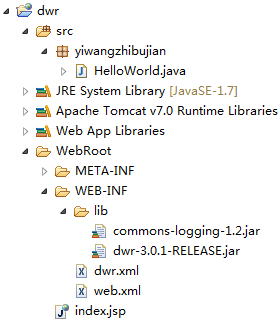
启动项目后访问:http://localhost:8080/dwr/,将有如下页面:

按顺序测试并输入指定的值,最终结果如下:
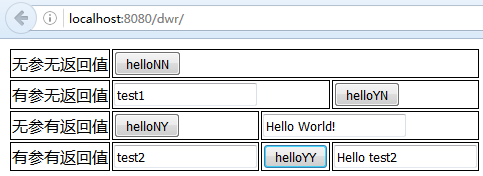
控制台输出内容如下:

经测试无误。
三、原理简单分析
3.1.访问页面时
当访问带有DWR页面的时候,引入js的请求会被,匹配到web.xml中的DWR的servlet(org.directwebremoting.servlet.DwrServlet):
<servlet>
<servlet-name>dwr-invoker</servlet-name>
<!-- 接收js的Ajax请求的servlet -->
<servlet-class>org.directwebremoting.servlet.DwrServlet</servlet-class>
</servlet>
<servlet-mapping>
<servlet-name>dwr-invoker</servlet-name>
<!-- 拦截指定的URL -->
<url-pattern>/dwr/*</url-pattern>
</servlet-mapping>
servlet会动态创建engine.js文件,并根据dwr/interface/HelloWorld.js,这种特定路径的文件名HelloWorld,去DWR配置文件dwr.xml中去查找相关配置:
<create creator="new" javascript="HelloWorld">
<param name="class" value="yiwangzhibujian.HelloWorld" />
</create>
查找到配置的对象后,并根据对象的所有方法动态创建HelloWorld对象,也会将所有方法生成相应的js方法,生成的HelloWorld.js如下:
if (typeof dwr == 'undefined' || dwr.engine == undefined) throw new Error('You must include DWR engine
before including this file');
(function() {
if (dwr.engine._getObject("HelloWorld") == undefined) {
var p;
p = {};
p.helloNN = function(callback) {
return dwr.engine._execute(p._path, 'HelloWorld', 'helloNN', arguments);
};
p.helloNY = function(callback) {
return dwr.engine._execute(p._path, 'HelloWorld', 'helloNY', arguments);
};
p.helloYN = function(p0, callback) {
return dwr.engine._execute(p._path, 'HelloWorld', 'helloYN', arguments);
};
p.helloYY = function(p0, callback) {
return dwr.engine._execute(p._path, 'HelloWorld', 'helloYY', arguments);
};
dwr.engine._setObject("HelloWorld", p);
}
})();
可以看到动态生成的对象包含java对象的所有方法,调用js方法会通过底层的Ajax调用相应的Java方法。
3.2 使用原因
- DWR是开源免费的
- 封装Ajax实现,可以很方便的调用
- 除此以外还有反向Ajax,即服务器推送功能,后续介绍
这一篇简单的介绍了DWR,并展示了一个js调用Java的例子,可以看出DWR对Ajax封装的非常好,调用起来很方便。下面一篇将会介绍逆向Ajax的用法。
来源:https://www.cnblogs.com/yiwangzhibujian/p/6145371.html